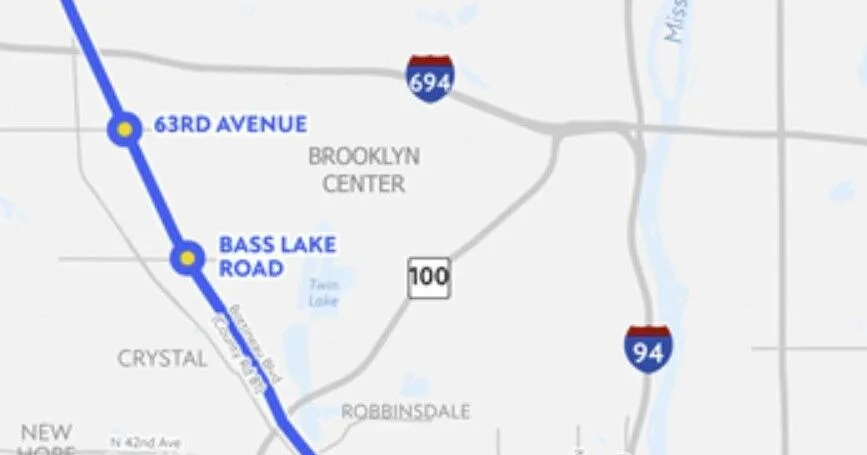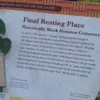
At least 24 properties will be partially or fully demolished according to the latest plan to extend the Blue Line light rail.
At least 24 properties will be partially or fully demolished according to the latest Blue Line extension plan. The proposed route goes through a historically Black neighborhood, sparking intense discussions among residents, business owners, and planners about displacement. While the expansion promises improved transportation and commercial development, concerns about derailing Black wealth are growing.
The north Minneapolis Black-led flagship radio station KMOJ confirmed it’s relocating due to projections that its building will be partially demolished to make room for a light rail station. The same is true for El Amin’s Fish House.
The Metropolitan Council began moving forward with a recommended route this fall but says it needs to pass an environmental review and get federal approval before finalizing it. Right now, the proposed extension goes up Washington Avenue from downtown. A new bridge over Interstate 94 will connect it to 21st. At James Avenue, it turns to West Broadway Avenue toward Penn Avenue, taking riders as far out as Brooklyn Park. Of the 24 properties impacted by this plan, 14 are commercial and 10 are residential. Some are vacant. Kyle Mianulli, principal communications specialist at Hennepin County, says, “This number is an estimate based on very preliminary designs. We are constantly refining plans to avoid building impacts.”
Northside cornerstones
The main north Minneapolis corridor in the proposed route has a high concentration of Black-owned businesses. During construction walk-ins are expected to decline impacting their sales and revenue. Here’s a list of businesses that will be impacted according to current plans.
Partially or fully demolished
KMOJ
Olympic Cafe
El Amin’s Fish House
J & J Furniture
Access impeded by construction
Capri Theatre
Wilson’s Image Barbers & Stylists
Anytime Fitness
Watson Chiropractor
Hollywood Dance Studio
Wolf Pack Promotions
In the original plan, the following Black-owned businesses would have been impacted but were spared by the revised proposal: Juxtaposition Arts, Shiloh Temple International, Sammy’s Eatery, Minneapolis NAACP offices, Black Family Blueprint, Black Women’s Wealth Alliance, Dimension’s In Hair Salon & Barbershop, NEON, Cookie Cart and more.
There is more at involved than closing doors. Discussions with those directly affected by the project reveal the complexities of urban development, equitable planning and community engagement.
The human impact
The proposed light rail path has stirred a range of emotions among north Minneapolis residents and local business owners. Many express a deep sense of confusion and fear about the possibility of displacement and loss of longstanding businesses. Teto Wilson purchased his commercial property in 2021 and planned to “buy the block” in effort to rebuild his neighborhood. While properties on his side of the street will not be demolished, he says the light rail ruined his future plans. He was in negotiations to purchase the building that houses KMOJ, but lenders pulled out when they found out it will be partially demolished.
Preserving Northside’s culture
While the Met Council touts the expansion as a step toward equitable development, concerns about the lack of clarity on details and timeline persist. Longtime resident Felicia Perry highlighted the need for more efforts around cultural preservation. “I want it to serve us … as a community, both in the physical space and culturally since there’s going to be displacement of culture,” said Perry. In Season 2 of “Here’s the Truth with Georgia Fort,” Roger Cummings, co-founder and executive director of Juxtaposition Arts, shared a similar sentiment. He said the proposed path will disrupt the fabric of the community, leading to significant changes in the socioeconomic landscape. Cummings and his family have anchored themselves in north Minneapolis for over two decades, investing millions in a new arts facility that would have been impacted by the first route.
Community engagement and outreach
Project planners have done a lot to connect with the community. However, their efforts have been scrutinized by some individuals who say they feel excluded from the decisionmaking process. “They have engaged us, but I don’t trust that it is meaningful engagement. This is just what they have to do. Most of my suggestions have not been implemented,” said Wilson. On the other hand, residents of Lynn Park and business owners on Broadway between 94 and Irving (Avenue) … have given input that directly impacted the changes made to the current route.
Route design and alternatives
The proposed route and its impacts have become a focal point of contention. “I’m not sure there is a best route. The proposed routes appear to be problematic for various communities,” said Freddie Bell, general manager of KMOJ. A lot of people suggested Olson Memorial Highway as a route to minimize displacement, but the Met Council says the path is not viable due to a railroad company denying them use of its land. Others have pointed to Interstate 94 as an alternative.
“I think most Northside residents thought Highway 55 would have been the absolute best and most non-invasive route, but it wasn’t offered,” said Lisa Spicer, owner of Dimensions In Hair Salon. Spicer owns the commercial property on West Broadway where her business has been located for 32 years. Her children work in the business and will inherit the property.
Anti-displacement
The overall impact is hard to visualize, so youth apprentices at Juxtaposition created a 3D model. That model is displayed at community meetings. As pictured to the left, the six buildings colored pink show what buildings will be demolished along the 21st Avenue portion of the route.
The anti-displacement efforts by Hennepin County and the Met Council aim to address the real and perceived risks of the project. The notion of cultural displacement is especially poignant, as a development of this scale will impact the community’s identity and people’s sense of belonging. For example, what happens when a pillar organization like KMOJ relocates? The Met Council says it will offer relocation funds, but the station has turned to the community to raise $50,000 for moving costs. When asked where the station will go, KMOJ’s general manager said it’s not decided yet. If the station leaves the Northside, the area would lose what has been affectionately known for nearly 50 years as “the heart and soul of the community.” The impact will be immeasurable. For those searching for answers about KMOJ’s relocation, their next monthly board meeting is Dec. 20. and is open to the public.
In a written statement the Met Council said “We are taking extraordinary steps to minimize property impacts wherever possible on this project. If it is necessary to purchase a property, we have a robust process to ensure owners are fairly compensated. We also work closely with renters and tenants to provide them with financial relocation assistance to make sure they can stay in the community or are able to easily move to another location of their choice.”
Moving forward with equitable development
The intricacies of the light rail expansion project in north Minneapolis underscore the delicate balance between progress and community preservation. As the project evolves, there is a critical need for transparent, inclusive and empathetic engagement with the impacted communities.
The Blue Line development is one project of many across America whose impact on Black neighborhoods will be felt for generations. Historically, transportation policies like the Federal Aid Highway Act of 1956 affected the development of Black communities. Now, we’re seeing a reckoning of those inequities through initiatives like Reconnect Rondo and Biden’s Infrastructure Plan. So projects like this can be triggering for Black communities, often leaving more questions than answers. Questions such as: Out of all the neighborhoods in Minneapolis that the light rail could go through, why the North Side neighborhood?
The voices of north Minneapolis residents and business owners stand as important reminders of the human stakes involved, urging planners to approach urban development with sensitivity, foresight and ethical responsibility.
Georgia Fort is an Emmy-winning independent journalist and creator and host of the television news program “Here’s the Truth with Georgia Fort.
Want to add your voice?
If you’re interested in joining the discussion, consider writing a Community Voices commentary or counterpoint. (For more information about Community Voices, see our Submission Guidelines.)
Originally posted on minnpost.com: https://www.minnpost.com/community-voices/2023/12/blue-line-plan-derails-black-businesses-in-north-minneapolis/#:~:text=Rail%20Transit%20Extension-,At%20least%2024%20properties%20will%20be%20partially%20or%20fully%20demolished,owners%2C%20and%20planners%20about%20displacement.


